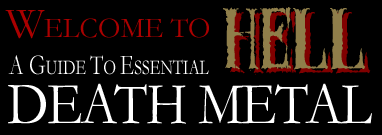| |
| |
Essential Death
metal albums? Is there such a thing? Damn straight there is. Death
metal has been around, in various permutations, since the early
Eighties so there's definitely enough of a history and body of
work to warrant examining some of the pillars of the genre. More
importantly, there are newer death metal fans out there who might
never have heard of bands like Sodom or Celtic Frost, groups that
are cornerstones of the field. A longtime fan may scoff at that
idea, but, hell, 40% of today's students don't know which side
Hitler was on in World War II. So where did death metal come from?
It was a natural --or unnatural, if you prefer-- offshoot of the
thrash/power metal scene, itself sired by the punk and New Wave
of British heavy Metal explosions of the late Seventies. Thrash
metal bands, like Exodus, Slayer and Metallica, while consistently
heavy, always kept a steady stream of melody running through their
music. But some hardcore fans and bands wanted something even
heavier, faster and uglier; they wanted metal taken to the very
extreme. So the tempos got quicker, the riffs got darker and more
brutal, and the vocals got hoarser, more guttural, until they
resembled screaming animals, instead of anything human. Death
metal shied away from traditional hooks or melodies, it was simply
an explosion of raw power and crushing heaviness. Of course, some
bands took the genre to rediculous extremes, while others refused
to progress. That's why there aren't too many quality death metal
albums being released nowadays, and why the genre has reverted
to mostly underground status. Other bands have broken out of the
death metal ghetto and continue to flourish --Sepultura being
a prime example. no matter what, there are a number of albums
that define the parameters of one of the few kinds of rock and
roll left that will definitely still annoy your parents.
|
|
| |
BE
THOU WARY! HERE LIE THE 15 ALBUMS THAT HAVE MADE DEATH METAL
ONE OF ROCK'S MOST LETHAL SUBDIVISIONS
|
|
| |
 |
|
 |
| |
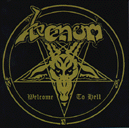
VENOM
Welcome to Hell
(Neat Records, 1981)
If there
is a granddaddy of death metal, this album could be
it. Venom came out of the starting gate with many of
the elements that formed the template for death metal
to come; fast, punk style tempos, a raw, brutal guitar
sound, harsh vocals and a sense of foreboding, amplified
by the band's unrelenting, obsession with Satan. On
the surface, this first Venom album was positively frightening:
it looked and sounded as evil as our parents envisioned
rock music to be. But the truth was, Venom consisted
of three dorks from Nothern England who didn't believe
any of the shit they wrote, and the amazingly raw sound
of their album was more a result of shitty production
than any agenda on the band's part. Nevertheless, Welcome
to Hell still holds up as one of the early Eighties'
most over-the-top metal albums. Venom released the even
more amazing Black Metal in '82, then rapidly
made one bomb after another for the next several years.
But the moster was unleashed.
--DK
|
|
 |
|
 |
 |
|
 |
| |
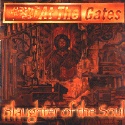
AT THE GATES
Slaughter of the Soul
(Earache, 1995)
The most
recent effort by this quintet also happens to be its
best. Over the course of its three previous albums,
At The Gates spawned the "Gothenburg sound"
(coined after their hometown in Sweden) whose signature
is high-speed tandem guitar work that makes equal use
of heavy chords and wandering melodies, along with a
particularly raw vocal delivery. There's a slew of other
bands that have followed suit, such as Dark Tranquillity
and In Flames -- U.S. fans probably aren't familiar
with the names, but they all bear further investigation,
Slaughter of the Soul signifies a landmark for
At The Gates -- and a sound that death metal up-and-comers
will hopefully embrace in coming years.
--UG
|
|
 |
|
 |
 |
|
 |
| |
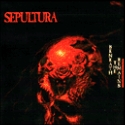
SEPULTURA
Beneath the Remains
(Roadrunner, 1989)
When Slayer's
Reign in Blood came out in 1986, many proclaimed
it the ultimate thrash metal album. For intensity, sheer
brutality, and dizzying dexterity, it simply could not
be beat. Sepultura tried with Beneath The Remains
and a lot of people think they came damned close.
Technically, Slayer is not death metal -- Tom Araya's
voice doesn't sound shredded enough-- but this little
Brazilian quartet immediately endeared itself to legions
of fans with this out-and-out classic. After recording
two albums released only in its native country, Sepultura
signed with Roadrunner in 1988 and recorded Beneath
the Remains in Rio de Janeiro. Perhaps driven by
a burning desire to escape Brazil, fueled by the band's
anger over its people's oppression by a corrupt government,
Sepultura delivered an album that is one long explosion
of fury. Beneath the Remains is utterly relentless,
but it's also filled with excellent songs --well-crafted
and arranged, brimming with memorable riffs and anthemic
choruses. It took a band from Brazil, previously a non-contender
in the international metal field, to show that death
metal could be about actually making music. The title
track, "Inner Self", "Mass Hypnosis"
and "Primitive Future" are just some of the
gems on this high-energy, low-fat monster of an album.
Sepultura has gone on to make even more progressive
albums, like Chaos A.D. and the upcoming Roots,
which have allowed them to keep their fan base, yet
ultimately transcend the confines of death metal. You
can count, on one hand, the bands that have made that
jump.
--DK
|
|
 |
|
 |
 |
|
 |
| |
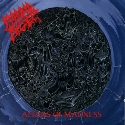
MORBID ANGEL
Altars of Madness
(Earache/Relativity, 1989)
When it
comes to musicianship, few death metal bands, past or
present, can compete with Florida-based veterans Morbid
Angel. Altars of Madness, Morbid's 1989 debut
album, featured some of the scariest and most musically
complex music in the death metal's history. A psychotic
whirlwind of twisted arrangements, stop-and-go-faster
rhythm shifts, and Satanic incantations, Altars of
Madness challenged the listener to comprehend its
intricacies and keep up with the pace --and rewarded
those who did with a truly dizzling display of hellspawn
rage and uncompromising musical prowess. While frontman
David Vincent's garbled vocals sounded only borderline
demonic, six-string wizard Trey Azagthoth played like
a man possessed. Each time he launched into one of his
spastic, skittering solos, it was as if the gates of
Hades opened up and let loose an army of enraged demons.
So close to pure evil, you should go to confessions
after listeing to it.
--JK
|
|
 |
|
 |
 |
|
 |
| |
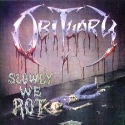
OBITUARY
Slowly We Rot
(Roadrunner, 1989)
Five years
after Morbid Tales, the influence of Celtic Frost
was still being felt. Obituary came out of nowhere (Florida,
actaully -- same thing) and took the warped Frost sound
to a new extreme, with down-tuned guitars, grinding
riffs and the impossibly guttural growls of vocalist
John Tardy creating a potent, if simple, stew. Slowly
We Rot is a cheap, bare-bones type of album, but
you can derive a sense of just how much these Southern
rednecks got a kick out of making it. For a low-budget
production, the sound is pretty thick, with piles of
steaming, gooey riffs dripping all over the rhythm section,
which alternates between excruciatingly slow jams and
bursts of sudden speed. The story goes that many of
the songs on the record --opuses with titles like "Internal
Bleeding" and "Bloodsoaked"-- didn't
actually have lyrics; Tardy just made noises that sounded
like words in his strangled delivery, and no one was
the wiser. Lyrics or not, the imagery of Obituary's
music helped bring the "gore" element to the
forefront of death metal. Songs about Satan and hell
were replaced with songs that read more like autopsy
reports or wartime atrocity descriptions. Obituary has
made pretty much the same album three more times, each
one a bit more proficient than the last , although the
band is reportedly breaking up. If so, then let this
be its epitaph.
--DK
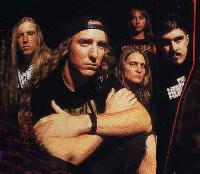
|
|
 |
|
 |
|
|
 |
|
 |
| |
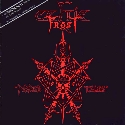
CELTIC FROST
Morbid Tales
(Noise, 1985)
There has
never been, and will probably never be again, a band
quite like Celtic Frost. Founded by visionary madman
Torn Fischer (aka, Tom Warrior). Frost could barely
play when it began life in Switzerland as Hellhammer
in the early Eighties. By the second full-length Celtic
Frost album, To Mega Therion, the band was adding
orchestral arrangements and operatic vocals to thunderous
epics of brutal death metal that led one critic to coin
the term 'avant-metal'. But even that album didn't capture
the primitive intensity of Morbid Tales, Frost's
beloved debut masterpiece. The production and playing
have not aged well, but Fischer's warped, tuned-down
guitar sound made Morbid Tales one of the heaviest
things the metal world had ever heard. Classics like
"Into the Crypts of Rays", "Return to
the Eve", and the brilliant "Procreation (of
the Wicked)" were bathed in sludgy, sinister waves
of monster riffing and boot-stomp drums, with Fischer
spitting out eerie lyrics about ancient civilizations
and elder gods. Pity it didn't last. Despite several
boldly experimental albums, Fischer was unhappy with
the band's underground status and went for an all-glam
gross-out on Cold Lake --one of the biggest career
mistakes in rock history. The band never recovered,
despite returning to a heavier style for another album
or two afterwards. Regardless, Morbid Tales,
To Mega Therion, and parts of Into the Pandemonium
are proof that Celtic Frost was one of the heaviest,
most unique metal bands to ever come down the pike.
--DK
|
|
 |
|
 |
 |
|
 |
| |

TERRORIZER
World Downfall
(Earache, 1989)
This one-off
side project melded several disparate influences (at
least at the time) into one powerful recording. Napalm
Death guitarist Jesse Pintado, Morbid Angel bassist
David Vincent, drummer Pete Sandoval and Nausea vocalist
Oscar Garcia came together for this recording, a project
supervised by a young producer named Scott Burns. The
manic, relentless work of Pintado and Sandoval fused
grindcore and death metal into one powerful package
that still holds up as perhaps the classic "side
project." Numerous others have been initiated since
then in an attempt to match the impact of this project,
but all have fallen well short of the mark.
--UG
|
|
 |
|
 |
 |
|
 |
| |
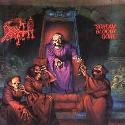
DEATH
Scream Bloody Gore
(Combat/Relativity, 1987)
One of the
earliest and still one of the best death metal records
ever, Scream Bloody Gore was the 1987 brainchild
of 16-year-old Floridian Chuck Schuldiner, one of the
genre's great pioneers. Though not nearly as refined
as more recent Death albums sucha as Individual
Thougth Patterns and Symbolic, Scream
Bloody Gore thrived on innocence, passion and determination.
At the time. Schuldiner's guitar and vocal skills were
admittedly primitive, but they were effective enough
to give the album an uncompromisingly gargantuan feel.
Infectiously catchy songs like "Regurgitated Guts",
"Torn to Pieces" and "Denial of Life"
showed Schuldiner (who also played bass on the record)
to have a keen yet simple sense of structure and composition,
not to mention the ability to create piledriving riffs
that hold up even to this day. Death hit the mark squarely
again in 1988 with Leprosy, the follow-up to
Scream Bloody Gore. Boasting a considerable improvement
in musicianship (Death was a real band this time, not
just Schuldiner and a drummer) and songwriting finesse,
Leprosy --fueled by such songs as "Pull
the Plug", "Born Dead" and "Left
to Die"-- solidified the band's status as one of
death metal's most respected outfits.
--JK
|
|
 |
|
 |
 |
|
 |
| |
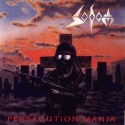
SODOM
Persecution Mania
(Steamhammer, 1987)
If there
was ever a ready-made market for death metal, it was
Germany. Those wild, drunken German fans saw metal as
a way of life and wanted it as hard and fast as possible.
Along came Sodom, who stunned tape traders everywhere
with their first demo, a blast of tuneless noise that
laid claim to containing the fastest song recorded to
that point, "Witchhammer". Sodom's first few
releases, including their full-length debut, Obsessed
by Cruelty, pointed up the fact that this trio (led
by legendary Tom Angelripper) really couldn't sing or
play. That's what made 1987's Persecutions Mania
such a pleasant surprise. Despite being only its second
full-length album, Persecutions Mania found Sodom
learning how to write some fairly intense material that
held together. "Nuclear Winter", "Electrocution"
and "Christ Passion" all have brutal riffs
and recognizable arrangements, even if drummer Chris
Witchhunter more often than not sounds like he's attempting
to beat the rest of the band to the end of the song.
That, in the end, was what made Sodom so lovable; they
always sounded like they were about to careen out of
control and crash off your turntable. Plus Tom's heavily
accented vocals ensured that you couldn't figure out
what the hell he was snarling about. Sodom continued
to release albums over the years, including some more
technically proficient efforts like Agent Orange
and Better off Dead. Once a cult item in the
U.S. and in its homeland, the band seems to have fallen
by the wayside in recent years. But Persecution Mania
remains a peak of Teutonic metal lunacy.
--DK
|
|
 |
|
 |
 |
|
 |
| |
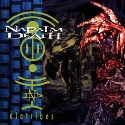
NAPALM DEATH
Diatribes
(Earache, 1996)
It's been
10 years since Napalm Death --the English five-piece
regularly hailed as grindcore, or 'extreme' metal, pioneers--
released its debut album, Scum. Napalm recently
returned to the scene the band helped establish with
Diatribes, arguably its most mature album to
date. Once prone to recroding psychotic blasts of detuned
spedd and calling them songs (one previous album, From
Enslavement to Obliteration, actually contained
54 tracks, many of them only a few seconds in length),
Napalm Death has clearly rethought its approach with
Diatribes, opting for a more controlled and wholly
more effective style of grind. Without forsaking its
trademark blast beats and guttural intensity, Napalm
has learned to harness its previously scattered power
and transform the sound into a pummeling, full-frontal
assault. Discipline (something Napalm Death have all
but avoided through much of its career) plays a key
role in why Diatribes hits the mark so squarely.
The result is an album brimming with meaty riffs, savage
vocals and well-crafted songs that have a distinct sense
of individuality. Songs like "Cold Forgiveness"
even generate a creepy, atmospheric quality rarely found
in death metal. Credit Napalm Death --the band who ushered
in the age of grindcore a decade ago-- with once again
pushing death metal's evolutionary envelope.
--JK
|
|
 |
|
 |
|
|
 |
|
 |
| |
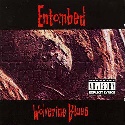
ENTOMBED
Wolverine Blues
(Earache/Columbia, 1994)
Death metal
in the Nineties has hardly been as exciting as it was
during the previous decade, due largely to a new breed
of bands whose only concern is to play faster and heavier
than their predecessors. This approach has succeeded
only in bringing death metal to new heights of sonic
ugliness, bleeding the genre dry of all its creativity
in the process. Enter Entombed, the remarkably disciplined
and talented Swedish five-piece that used its unwavering
originality to produce Wolverine Blues. 1994's
best death metal effort and quite possibly the finest
death metal album so far this decade. A benchmark of
brilliantly crafted songs, powerful vocals and intelligent
lyrics --three qualities not often found in modern death
metal-- Wolverine Blues single-handedly gave
death metal the shot in the arm it so desperately needed
since blast beats, harmonized demon vocals and inaudible
guitar noise became the tools of choice for its craftsmen.
unlike many of its contemporaries, Entombed isn't content
with merely tuning down the guitars and playing at warp
speed in order to achieve a heavy sound. For this band
the steamroller heaviness of Wolverine Blues is
simply the end result of writing songs that crush the
living daylights out of the listener. Seething with
Entombed's signature passion and rage, tracks like "Hollowman",
"Full of Hell" and "Demon" are some
of the best the field has to offer. Ultimately, they
make Wolverine Blues the standard by which all
future death metal records should be judged.
--JK
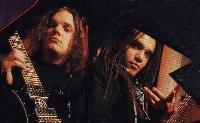
|
|
 |
|
 |
 |
|
 |
| |
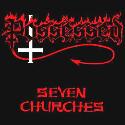
POSSESSED
Seven Churches
(Combat/Ralativity, 1985)
Few death
metal albums have ever had the distinction of truly
being scary. When Possessed exploded out of San Francisco
with Seven Churches in 1985, a wave of terror
swept through the death metal underground that conjured
up images of gory Satanic rituals and demonic possession
for anyone who dared spin its diabolic grooves. From
the creepy opening chime of "Tubular Bells"
from The Exorcist (here called 'The Exorcist'),
and on through its 12 songs of blood-drenched primal
rage, Seven Churches was the musical equivalent
of The Evil Dead or some other grotesque horror
movie. Featuring a young and obviously impressionable
Larry LaLonde (now in Primus) on guitar, Seven Churches
teetered on the brink of being an uncontrollable
metal mess while still retaining an undeniable sense
of power and fury. Song titles like "Burning in
Hell", "Pentagram", "Satan's Curse"
and "Holy Hell" summed it up perfectly; Seven
Churches was ugly as sin, but at the same time it
brilliantly captured the true essence of death metal.
Possessed (prior to the shooting of vocalist Jeff Becerra
during a drug deal gone awry, leaving him paralyzed
from the waist down and mentally unsound) went on to
release 1986's hidiously raw Beyond the Gates and
finally The Eyes of Horror, a strangely musical
EP produced by Joe Satriani.
--JK
|
|
 |
|
 |
 |
|
 |
| |

"Possessed's
frantic riffing and broken time signatures definitely
influence Morbid Angel. Larry LaLondes's soloing was
was totally creative and Jeff Becerra had some of the
most hideous, growling vocals ever. Seven Churches is
truly one of the great, all time death metal records."
Trey
Azagthoth - Morbid Angel
|
|
 |
|
 |
 |
|
 |
| |
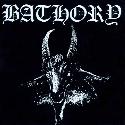
BATHORY
Bathory
(Black Mark, 1985)
It's amazing
how some bands just stick around and keep making music.
Witness Bathory, a one-man band featuring Quorthon,
the reclusive Swedish maniac who first captured hardcore
fans' attention with two songs on an early-Eighties
compilation called Scandinavian Metal Attack.
To this day, Quorthon continues to make records. Like
Celtic Frost, Bathory exhibited little musical expertise
at first, or any real songwriting; but the sound was
just so diabolical that fans of extreme metal were attracted
instantly. Bathory cemented the pseudo-band's
reputation as a total deathfest and raised questions
about this mysterious outfit. It soon became apparent
that Quorthon's stories about having a full band were
nothing but a hoax. But it didn't matter, 'cause kids
took the Bathory sound like maggots to a corpse. The
buzzsaw guitars, insanely fast drumming, and the demon-who-just-woke-up-on-the-wrong-side-of-the-flaming-pit
vocals were simply out of this world. Like several other
classics of death metal, Bathory doesn't hold
up as well today. Those buzzin' guitars sound tinny,
more like a fly than a chainsaw. And the songs are simplistic,
little three-minute races to the finish line. But talent-free
as Quorthon was at the time (he's since progressed to
writing epic metal saga about Vikings and things like
that), he still managed to drench his early work in
gobs of atmosphere. And albums like this, The Return
and Under the Sign of the Black Mark have had
an undeniable impact on today's death metal.
--DK
|
|
 |
|
 |
 |
|
 |
| |
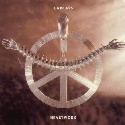
CARCASS
Heartwork
(Earache/Columbia, 1994)
When it
comes to the "gore" subdivision of death metal,
no one perfected the art-form quite like this band.
Carcass's early albums were filled with pictures of
just that --human insides, strewn across lab tables
and car wrecks, along with other fine collages of corpses,
burnt and rotting flesh and plenty more. Jeff Walker's
lyrics were not to be taken seriously --they read as
if he simply cut and pasted words together from forensic
textbooks. And the music was a tuned-down morass of
sludgy doom alternating with hyperspeed rhythms-- in
short, virtually tuneless. That all changed with Heartwork.
Gone were the ridiculous lyrics and the start-and-stop
approach to songs. This time, the band roared through
real songs, with real choruses and a newfound sense
of dynamics and, gasp, even a bit of melody. Hardcore
fans wailed, but it was clear that Carcass had to progress
at some point. The band should receive credit for maintaining
the basic heaviness of its music, while at the same
time making the most listenable ablum of its career.
And perhaps its last. Recent reports indicate internal
turmoil in the band, brought about by guitarist/founder
Bill Steer's unhappiness with the record industry. Whatever
happens, Carcass remains one of the best latter-day
death metal acts, and Heartwork is its most accomplished
hour.
--DK
|
|
 |
|
 |
 |
|
 |
| |
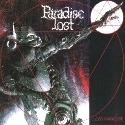
PARADISE LOST
Lost Paradise
(Peaceville, 1989)
There was
such an intense amount of intrigue and curiosity surrounding
this British band's first album, perhaps because Lost
Paradise set the standard for doom/death albums
to come. Granted, it was under-produced and plodding,
and Nick Holmes' vocals must have brought on numerous
throat polyps, but what it lacked in budget it made
up for in atmoshpere (kinda like those classic Hammer
films). Never before had a group reveled in as much
depression --"sorrow-filled blessings," indeed.
The band eventually grew to a modern-day incarnation
of a EuroMetallica, but its use of somber, prolonged
guitar melodies are still being imitated to this day.
--UG
|
|
 |
|
 |
|
|
|
|
